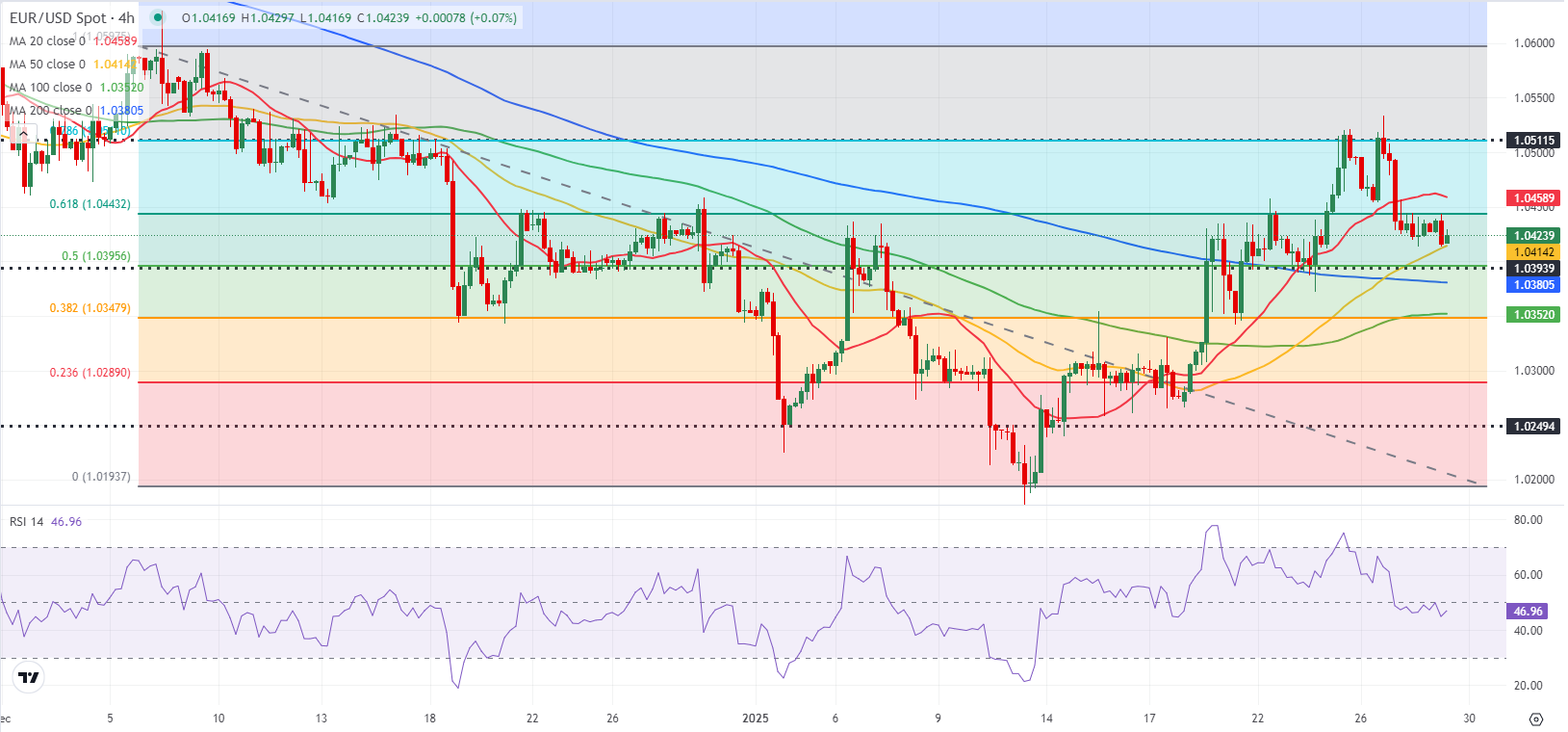- EUR/USD stays below 1.0450 after closing in negative territory on Tuesday.
- The Fed is widely anticipated to leave monetary policy settings unchanged.
- The technical outlook points to a bearish tilt in the near term.
EUR/USD lost more than 0.5% on Monday as the US Dollar (USD) benefited from the souring risk mood. The pair struggles to hold its ground in the European morning on Wednesday and trades below 1.0450 as investors gear up for the Federal Reserve's (Fed) monetary policy announcements.
Euro PRICE This week
The table below shows the percentage change of Euro (EUR) against listed major currencies this week. Euro was the weakest against the Japanese Yen.
| USD | EUR | GBP | JPY | CAD | AUD | NZD | CHF | |
|---|---|---|---|---|---|---|---|---|
| USD | 0.69% | 0.27% | -0.28% | 0.38% | 1.25% | 0.86% | -0.01% | |
| EUR | -0.69% | -0.34% | -0.81% | -0.17% | 0.55% | 0.29% | -0.59% | |
| GBP | -0.27% | 0.34% | -0.77% | 0.18% | 0.90% | 0.65% | -0.25% | |
| JPY | 0.28% | 0.81% | 0.77% | 0.70% | 1.70% | 1.38% | 0.41% | |
| CAD | -0.38% | 0.17% | -0.18% | -0.70% | 0.67% | 0.48% | -0.42% | |
| AUD | -1.25% | -0.55% | -0.90% | -1.70% | -0.67% | -0.22% | -1.10% | |
| NZD | -0.86% | -0.29% | -0.65% | -1.38% | -0.48% | 0.22% | -1.11% | |
| CHF | 0.00% | 0.59% | 0.25% | -0.41% | 0.42% | 1.10% | 1.11% |
The heat map shows percentage changes of major currencies against each other. The base currency is picked from the left column, while the quote currency is picked from the top row. For example, if you pick the Euro from the left column and move along the horizontal line to the US Dollar, the percentage change displayed in the box will represent EUR (base)/USD (quote).
Headlines surrounding US President Donald Trump's trade policies caused market participants to adopt a cautious stance on Tuesday, helping the USD capitalize on safe-haven flows. Trump's press secretary Karoline Leavitt said late Tuesday that the plan to impose Canada and Mexico with punishing tariffs on February 1 was still in play.
The Fed is widely anticipated to leave the interest rate unchanged at 4.25%-4.5% following the first policy meeting of the year. Investors will pay close attention to comments from Chairman Jerome Powell in the press conference starting at 19:30 GMT.
In case Powell reiterates their willingness to remain patient regarding further policy-easing, citing the uncertainty surrounding the impact of new economic policies on prices and growth outlook, the USD could stay resilient against its peers. On the other hand, the USD could come under pressure if Powell sounds more optimistic about inflation, noting the fact that Trump refrained from announcing day-one tariffs.
EUR/USD Technical Analysis
The Relative Strength Index (RSI) indicator on the 4-hour chart stays below 50 and EUR/USD remains well below the 20-period Simple Moving Average (SMA), reflecting the bearish stance.
Looking south, first support could be spotted at 1.0380-1.0390 (200-period Simple Moving Average, Fibonacci 50% retracement of the latest downtrend) before 1.0340-1.0350 (Fibonacci 38.2% retracement, 100-period SMA) and 1.0300 (static level, round level).
In case EUR/USD manages to reclaim 1.0440 (Fibonacci 61.8% retracement), next resistance could be spotted at 1.0500-1.0510 (round level, Fibonacci 78.6% retracement) ahead of 1.0540 (static level) and 1.0600 (beginning point of the downtrend).
Euro FAQs
The Euro is the currency for the 19 European Union countries that belong to the Eurozone. It is the second most heavily traded currency in the world behind the US Dollar. In 2022, it accounted for 31% of all foreign exchange transactions, with an average daily turnover of over $2.2 trillion a day. EUR/USD is the most heavily traded currency pair in the world, accounting for an estimated 30% off all transactions, followed by EUR/JPY (4%), EUR/GBP (3%) and EUR/AUD (2%).
The European Central Bank (ECB) in Frankfurt, Germany, is the reserve bank for the Eurozone. The ECB sets interest rates and manages monetary policy. The ECB’s primary mandate is to maintain price stability, which means either controlling inflation or stimulating growth. Its primary tool is the raising or lowering of interest rates. Relatively high interest rates – or the expectation of higher rates – will usually benefit the Euro and vice versa. The ECB Governing Council makes monetary policy decisions at meetings held eight times a year. Decisions are made by heads of the Eurozone national banks and six permanent members, including the President of the ECB, Christine Lagarde.
Eurozone inflation data, measured by the Harmonized Index of Consumer Prices (HICP), is an important econometric for the Euro. If inflation rises more than expected, especially if above the ECB’s 2% target, it obliges the ECB to raise interest rates to bring it back under control. Relatively high interest rates compared to its counterparts will usually benefit the Euro, as it makes the region more attractive as a place for global investors to park their money.
Data releases gauge the health of the economy and can impact on the Euro. Indicators such as GDP, Manufacturing and Services PMIs, employment, and consumer sentiment surveys can all influence the direction of the single currency. A strong economy is good for the Euro. Not only does it attract more foreign investment but it may encourage the ECB to put up interest rates, which will directly strengthen the Euro. Otherwise, if economic data is weak, the Euro is likely to fall. Economic data for the four largest economies in the euro area (Germany, France, Italy and Spain) are especially significant, as they account for 75% of the Eurozone’s economy.
Another significant data release for the Euro is the Trade Balance. This indicator measures the difference between what a country earns from its exports and what it spends on imports over a given period. If a country produces highly sought after exports then its currency will gain in value purely from the extra demand created from foreign buyers seeking to purchase these goods. Therefore, a positive net Trade Balance strengthens a currency and vice versa for a negative balance.
Information on these pages contains forward-looking statements that involve risks and uncertainties. Markets and instruments profiled on this page are for informational purposes only and should not in any way come across as a recommendation to buy or sell in these assets. You should do your own thorough research before making any investment decisions. FXStreet does not in any way guarantee that this information is free from mistakes, errors, or material misstatements. It also does not guarantee that this information is of a timely nature. Investing in Open Markets involves a great deal of risk, including the loss of all or a portion of your investment, as well as emotional distress. All risks, losses and costs associated with investing, including total loss of principal, are your responsibility. The views and opinions expressed in this article are those of the authors and do not necessarily reflect the official policy or position of FXStreet nor its advertisers. The author will not be held responsible for information that is found at the end of links posted on this page.
If not otherwise explicitly mentioned in the body of the article, at the time of writing, the author has no position in any stock mentioned in this article and no business relationship with any company mentioned. The author has not received compensation for writing this article, other than from FXStreet.
FXStreet and the author do not provide personalized recommendations. The author makes no representations as to the accuracy, completeness, or suitability of this information. FXStreet and the author will not be liable for any errors, omissions or any losses, injuries or damages arising from this information and its display or use. Errors and omissions excepted.
The author and FXStreet are not registered investment advisors and nothing in this article is intended to be investment advice.
Recommended Content
Editors’ Picks

EUR/USD hits two-week tops near 1.0500 on poor US Retail Sales
The selling pressure continues to hurt the US Dollar and now encourages EUR/USD to advance to new two-week peaks in levels just shy of the 1.0500 barrier in the wake of disappointing results from US Retail Sales.

GBP/USD surpasses 1.2600 on weaker US Dollar
GBP/USD extends its march north and reclaims the 1.2600 hurdle for the first time since December on the back of the increasing downward bias in the Greenback, particularly exacerbated following disheartening US results.

Gold maintains the bid tone near $2,940
The continuation of the offered stance in the Greenback coupled with declining US yields across the board underpin the extra rebound in Gold prices, which trade at shouting distance from their record highs.

Weekly wrap: XRP, Solana and Dogecoin lead altcoin gains on Friday
XRP, Solana (SOL) and Dogecoin (DOGE) gained 5.91%, 2.88% and 3.36% respectively on Friday. While Bitcoin (BTC) hovers around the $97,000 level, the three altcoins pave the way for recovery and rally in altcoins ranking within the top 50 cryptocurrencies by market capitalization on CoinGecko.

Tariffs likely to impart a modest stagflationary hit to the economy this year
The economic policies of the Trump administration are starting to take shape. President Trump has already announced the imposition of tariffs on some of America's trading partners, and we assume there will be more levies, which will be matched by foreign retaliation, in the coming quarters.

The Best Brokers of the Year
SPONSORED Explore top-quality choices worldwide and locally. Compare key features like spreads, leverage, and platforms. Find the right broker for your needs, whether trading CFDs, Forex pairs like EUR/USD, or commodities like Gold.
